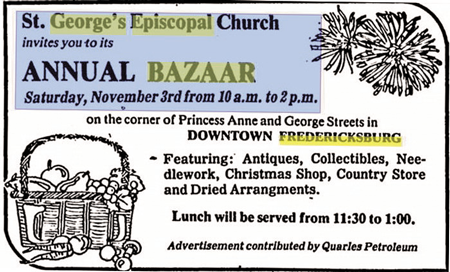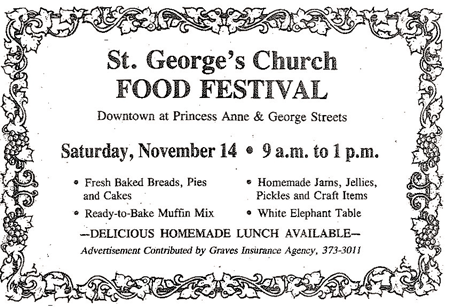
Growing up in Fredericksburg, the St. George’s Episcopal Bazaar was one of the earliest signs Christmas was on the way.
Recently, I was noticing how many churches hold a special money raising activity involving the entire church. In this region of the Diocese, there is a car show, a silent auction, yard sale and a Fall Festival that take into account 4 of the 19 churches in this area. My mind drifted back to my neighbor on Hanover Street making items for “the bazaar”, including needlepoint and ceramics. Obviously we don’t have one today. When was the first and why was it started? Why did the event end? What difference did it make in our history?
The bazaar goes back into the years after World War II. The earliest bazaar was held in Dec., 1947. The first mention of a bazaar was in May, 1947 when minutes of the Women’s Auxiliary (the earlier organization for the ECW) contained the statement that “Plans discussed for a bazaar to be held in December.” No mention why they decided to undertake it. However, in March, 1947 Rev. Thomas Faulkner, in his first year at St. George’s, gave them a talk about the needs of the church. These included 1. Robes for the choir 2. Tables to serve suppers 3. A refrigerator for the kitchen 4. A new set of altar linens and finally 5 kneeling pads for the church. Did this lead them into a direction of a new money making project for these needs ? The minutes are silent on this point. There were 9 chapters of the Women’s Auxiliary and each chapter appointed a member to be part of the executive committee to plan the event. It was clear it was done throughout the year.
By the 1954, the event had expanded to two days. In that year it was held on December 1 and 2 from 10am to 9pm. They served two lunches and dinners. Whew!
In The Woman’s Auxiliary to the National Council Virginia Diocesan Branch Report for 1955, Lucy Warner Chinn, President, reports:
“We made $1,447.50 on our Bazaar and we have left in the treasury $553.03. Since our Board has not met to decide how we will spend this $2,000, I cannot state how much we will give to parish projects. It will, however, go to paying for new kitchen equipment, new equipment for the Sunday School and go on the Rectory debt. Not listed on this report is approximately $200.00 left in the chapters and given by them for a worthy cause.”
By the 1970’s it was clear the endeavor was not just an ECW project but one for the Church. In 1977, the Executive Committee met with the vestry on Sept. 20. The Women of the Church expressed gratitude for the “generous allocation of funds from the Bazaar profits to the Churchwomen’s treasury.” Other groups contributed. In 1980, the church men cooked beef stew and hot dogs and the youth sold t-shirts.
The profits became larger. In 1978, the ECW held the Bazaar on November 4. Cindy Helton, who contributed significantly to this article, remembers there were “Bazaar Workshops” that went on every Tuesday, 10:00 a.m. prior to the actual Bazaar event. Betty Poole reported that the 1978 Bazaar netted $4,025.25.
What did they sell? An ad from 1979 mentioned “antiques, collectibles, needlework, Christmas shop, Country store and dried arrangements.
We have an entire notebook on the November 14, 1981 bazaar that was held from 10am to 2pm with lunch between 12pm and 1:30pm. Subcommittees were organized for the following areas 1. Luncheon 2. Holiday area 3. Needlework area 4. Children’s play 5. White Elephant 6. Book Sales 7. Pantry Shelf Area 8. Pressed Flower note power 9. Silk flowers and dried flowers 10. Raffles 11. Workshops 12 Booths 13 Telephone. The bazaar took the Family Room, Library, and Sunday school.
The bazaar resembled a walk down a country fair. It was organized around booths with items for sale –needlework, book stall, country cupboard with gourmet shelf, holiday shop, white elephant sale, Pantry shelf (jams, jellies, vegetables). Workshops were conducted on Pressed Flower notepaper, sewing/needlework, and quilting. Finally raffles were held for a Bachelor chest, Fredericksburg lamp and quilt.

The Bazaar hit a high point at that time with funds raised – approximately $4,700 . By 1982 they were forecasting less money from the project in their budget – $3,500. It was time to revisit the bazaar and it was renamed the “Country Store and Bake Sale.” Kathryn Haymes was the chairperson and it netted $2,040.85.
The name was to be continued in 1983. However, in October, Betty Poole recommended it to be changed to the “Food Festival” featuring a variety of canned foods and baked goods. The name stuck but the concept of the bazaar had been cut back.
Cindy Helton who assisted in this article remembered “baking a sour cream pound cake for the St. George’s Bazaar in 1987 and again in 1988.” We have a collection records from 1987 that show $2,280 collected. Many of the food items (canned foods, baked , baskets), white elephant sale remained from the old Bazaar and some craft items.
Unfortunately the ECW records become less by the 1980’s and into the early 1990’s so it is difficult to tell when it ended. The latest evidence is 1994.
A Free Lance-Star ad in 1991 seemed to indicate a return to a bazaar with needlepoint, jewelry, Christmas ornaments, wreaths, teddy bears as well as food (baked goods, homemade jams, pickles). The hours were longer 9am-3pm. A new project was on the horizon for fund raising – a major renovation of the St. George’s kitchen.
A Free Lance-Star article in 1994 advertised the Nov. 12th bazaar which featured a reproduction of the 1960 church cookbook it also mentioned ginger bread cut in the shape of horses.
Betty Poole who worked bazaars from 1976 speculated that several trends led to the end of the Bazaar – 1. Changes in the labor force with more women choosing careers with less time to work for the church 2. Other non-profits, such as garden clubs with their own activities. She especially remembered the work of Katherine Haymes making jams, jellies and pickles for the event and other groups, such as the youth helping.
The project was the largest money making project for the Women’s Auxiliary comprising half of their funds, at a time when significant funding was necessary for both their projects and the needs of the church. It also unified the chapters – it was the one activity planned during the year that brought together the organization when there were nine separate chapters. In later years other groups of the church pitched in. Betty Poole enjoyed the process of organizing the event and getting to know the chapter members in the process.
The best comment about the Bazaar/Food Festival was made in April, 1987 when the Treasurer of one of the chapters, Jo Boxell, was lamenting the poor contributions one month. “It isn’t much but then our chapter has never been known to be wealthy except when giving luncheons.”
– Ben Hicks with major help from Cindy Helton
